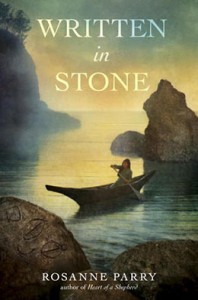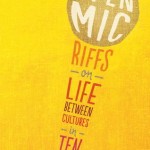Debbie Reese in her review of Written in Stone asked me about the petroglyphs in the story and why I invented them rather than using actual petroglyphs from the village of Ozette, where my story is placed.
In the story the petroglyphs play a key role in helping Pearl uncover and claim her vocation as a writer and historian for her tribe. The ownership of artwork is a matter I take very seriously and to use an actual rock carving done by a Makah artist and put it in my book with no way of asking permission or compensating that artist fairly for his work would simply be wrong. So instead I invented a group of rock carvings based the carving style and technique I’ve seen while hiking in this area but copying none of them. To my thinking this is the more just course. Taking what’s
 not mine is wrong. Making things up is what a fiction writer does. When the cover team was meeting I sent them a bunch of photographs of the Olympic Peninsula so they could get a feel for the ecosystem. The pictures included one of a petroglyph which is on public land and which commonly appears in works of non-fiction. I was so happy to see Richard Tuschman, the cover artist, incorporate a few petroglyphs on the cover–inventing an element in the style of this art but not stealing what’s not his to copy.
not mine is wrong. Making things up is what a fiction writer does. When the cover team was meeting I sent them a bunch of photographs of the Olympic Peninsula so they could get a feel for the ecosystem. The pictures included one of a petroglyph which is on public land and which commonly appears in works of non-fiction. I was so happy to see Richard Tuschman, the cover artist, incorporate a few petroglyphs on the cover–inventing an element in the style of this art but not stealing what’s not his to copy.
The other major plot element which is made up is the natural gas vent at Shipwreck Cove and the stories the tribe uses to keep children away from a dangerous place. The accusation that I’ve made up stories that don’t exist is dead wrong. I’ve told no stories belonging to the Quinault or Makah, real or made up. I have pointed out something that is distinctive and interesting about their culture though. These tribes use monster stories to keep their children away from danger without having to hover over them constantly. I was struck by how much freedom young people in the community had during my time in Taholah. They walked all over town freely and without immediate supervision but still under the watchful care of the entire community. Places that might be dangerous, such as the ocean with it’s powerful undertow and the dump which attracts bears, were bounded about, not with fences, but with scary stories that kept kids from wandering into harm’s way. If there was a natural gas vent near the town (and there might be, there were places I was asked not to go myself when I lived there) then certainly there would be stories to warn children away.
 As I say in the authors note the cove and its contents are my invention. Whether or not petroleum is present on the Quinault or Makah reservations is something you’d have to ask them about. Each tribe has a natural resources department and they are the ones to speak (or decline to speak) about their reservation lands. Natural gas is present all over the non-reservation areas of the Olympic Peninsula but it’s not abundant enough that anyone has drilled for it so far. Wildcatting in search of oil and natural gas was very common in the 1920s, and business men with an eye to a quick profit were often unscrupulous in acquiring mineral rights to land. This is not only an injustice directed toward Native Americans. Many white farmers and ranchers fell victim to their swindles as well. And frankly, I’m tired of stories that cast the Indian as the hapless victim. I wanted a story where the Native American kid won and did so, not in some wildly unrealistic battle or singlehanded act of heroism, but in the manner that most of life’s battles are won: with words, and community, and the hard work of many years.
As I say in the authors note the cove and its contents are my invention. Whether or not petroleum is present on the Quinault or Makah reservations is something you’d have to ask them about. Each tribe has a natural resources department and they are the ones to speak (or decline to speak) about their reservation lands. Natural gas is present all over the non-reservation areas of the Olympic Peninsula but it’s not abundant enough that anyone has drilled for it so far. Wildcatting in search of oil and natural gas was very common in the 1920s, and business men with an eye to a quick profit were often unscrupulous in acquiring mineral rights to land. This is not only an injustice directed toward Native Americans. Many white farmers and ranchers fell victim to their swindles as well. And frankly, I’m tired of stories that cast the Indian as the hapless victim. I wanted a story where the Native American kid won and did so, not in some wildly unrealistic battle or singlehanded act of heroism, but in the manner that most of life’s battles are won: with words, and community, and the hard work of many years.

